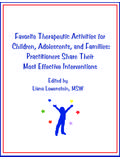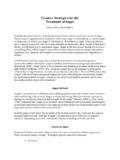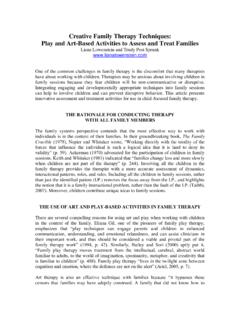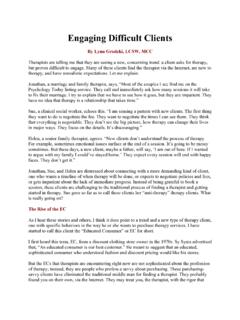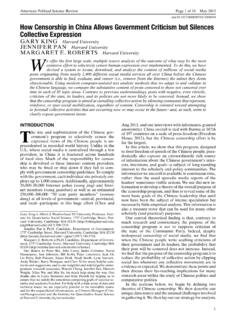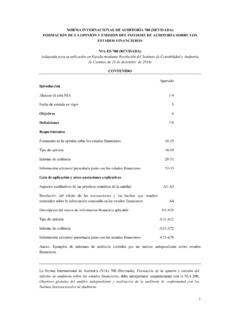Transcription of Creative Family Therapy Techniques: Play and Art-Based ...
1 Creative Family Therapy Techniques: Play and Art-Based Activities to Assess and Treat Families Liana Lowenstein and Trudy Post Sprunk One of the common challenges in Family Therapy is the discomfort that many therapists have about working with children. Therapists may be anxious about involving children in Family sessions because they fear children will be non-communicative or disruptive. Integrating engaging and developmentally appropriate techniques into Family sessions can help to involve children and can prevent disruptive behavior.
2 This article presents innovative assessment and treatment activities for use in child-focused Family Therapy . THE RATIONALE FOR CONDUCTING Therapy WITH ALL Family MEMBERS The Family systems perspective contends that the most effective way to work with individuals is in the context of their families. In their groundbreaking book, The Family Crucible (1978), Napier and Whitaker wrote, Working directly with the totality of the forces that influence the individual is such a logical idea that it is hard to deny its validity (p.)
3 59). Ackerman (1970) advocated for the participation of children in Family sessions. Keith and Whitaker (1981) indicated that families change less and more slowly when children are not part of the Therapy (p. 244). Involving all the children in the Family Therapy provides the therapist with a more accurate assessment of dynamics, interactional patterns, roles, and rules. Including all the children in Family sessions, rather than just the identified patient ( ) removes the focus away from the , and highlights the notion that it is a Family interactional problem, rather than the fault of the (Taibbi, 2007).
4 Moreover, children contribute unique ideas to Family sessions. THE USE OF ART AND PLAY-BASED ACTIVITIES IN Family Therapy There are several compelling reasons for using art and play when working with children in the context of the Family . Eliana Gil, one of the pioneers of Family play Therapy , emphasizes that play techniques can engage parents and children in enhanced communication, understanding, and emotional relatedness, and can assist clinicians in their important work, and thus should be considered a viable and pivotal part of the Family Therapy work (1994, p.)
5 42). Similarly, Bailey and Sori (2000) aptly put it, Family play Therapy moves treatment from the intellectual, cerebral, abstract world familiar to adults, to the world of imagination, spontaneity, metaphor, and creativity that is familiar to children (p. 488). Family play Therapy lives in the twilight zone between cognition and emotion, where the defenses are not on the alert (Ariel, 2005, p. 7). Art Therapy is also an effective technique with families because it bypasses those censors that families may have adeptly construed.
6 A Family that did not know how to express feelings directly may find a way to do so when given an opportunity to draw or paint (Klorer, 2006, p. 115). When Family members engage in an arts or play-based therapeutic activity, they often express thoughts and feelings that they otherwise may not feel comfortable expressing through traditional Family talk Therapy . Art and play-based activities can unlock a deeper level of communication. Play and arts therapies differ from traditional talk Therapy in that they engage emotions in a direct and physical way, generate Creative energy as a healing force, and creatively enable clients to express their problems and conflicts (Malchiodi, 2005).
7 ENGAGING THE Family IN PLAY AND ART ACTIVITIES Parents may have difficulty understanding the rationale and effectiveness of using play and art techniques in Family Therapy sessions. They may view games, drawings, and puppets merely as sources of entertainment for children. Parents may also feel uncomfortable, embarrassed, or silly participating in playful Family Therapy . It is helpful to meet with parents prior to the first Family session to explain the value of using play and art activities in Family Therapy and to help them embrace this approach.
8 Wark (2003) outlines the following instructions for the parent session: 1. Inform parents that play and art activities are a part of your Family Therapy approach. Give examples of the techniques that are usually incorporated into sessions, such as games, drawings, and puppets. Ask the parents for their reaction to this method of working. If the parents express doubt or discomfort with this approach, normalize their feelings. 2. Ask the parents for their image and expectations of Therapy , , What are your ideas of how Therapy should be conducted with families?
9 What do you think would help your children feel comfortable in Therapy ? Do you think it will be easy or difficult for your children to talk directly and openly about their thoughts and feelings? Do you think your children will be able to sit still during the entire session? What would help your children participate in the sessions? 3. Explain some of the key benefits of using play and art techniques in Family Therapy : (a) children enjoy games, drawing, and using puppets, therefore they will feel comfortable with a play-based approach; (b) since children communicate through play, they will be able to express themselves more easily than traditional talk Therapy ; (c) since play and art activities are active in nature, children s attention is more likely to be captivated and sustained for the duration of the session.
10 And (d) research shows that play helps children develop cognitive, affective, and sensorimotor skills (Singer, 1996). When introducing play and art interventions into Family sessions, it is helpful to begin with activities that guarantee success; these tasks should be easy and should not require an explicit finished product. In addition, if the Family members are asked to work as a group or in pairs, they may feel less conscious of their own contribution (Revell, 1997). INTERVENTIONS Techniques that are fun and engaging help to minimize resistance and involve the Family in Therapy .
